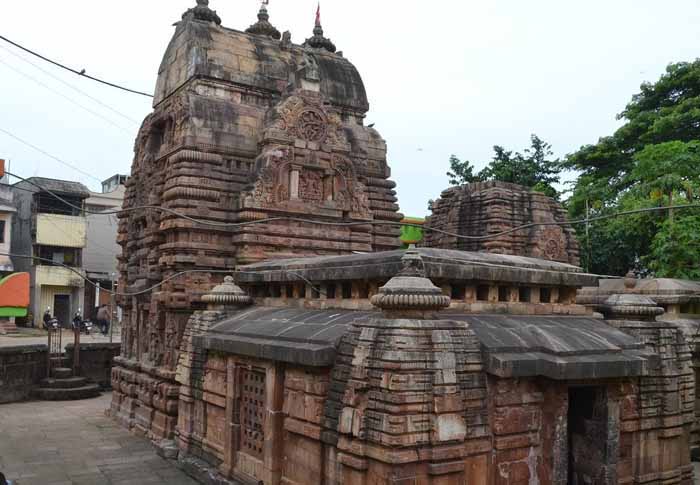Baitala Deula

Information of Baitala Deula, Bhubaneswar, Odisha
The Baitala Deula is yet another ancient temple located in the capital city of Orissa that is Bhubaneswar in the Khurda district. This is a Hindu temple dedicated to Goddess Durga here worshipped as Chamunda or Shakti or Kapalini. Locally the temple is also known as Tini Mundia Mandira. The Baitala Deula is a Shakti temple who is considered as the source of all power and knowledge of the universe.
Baitala Deula Religious Significance
The Goddess Chamunda worshipped in the Baitala temple is a very ferocious form of Goddess Shakti. She is referred to as the "God of war" and 'epidemics of pestilent Diseases, famines and other disasters'. Her abode is usually fig trees or cremation grounds. She is considered as Goddess who kills all the demons and drinks their blood. Chamundi is no one but one of the seven form of the Mother Goddess Durga of the Hindus. Goddess Chamundi is usually seen mounted on a corpse or an owl. Chamundi is mainly worshipped in a grand way during full moon or amvasya. The people following tantric tradition also worship in the temple. Since Chamundi is greatly associated with Lord Shiva as his consort and having part of his Shakti Shivaraatri is also celebrated in the temple.
Only Hindu people can enter the main shrine of the temple and no non Hindu or pets are allowed.
Baitala Deula Mythology & History
The present temple was constructed in 9th century. Some of the local people are true worshippers of Devi Chamundi as she blesses her devotees with a fruitful and pleasing life.
According to the legends Chamunda was basically worshipped by the Munda people from the Vindhya Range in central India. They sacrificed animal and also humans in order to offer to the Devi along with wine or liquor. These rituals are closely related to Tantric religion. It started spreading far and wide until it reached the east coast of India.
Another legend tell us that Goddess Durga the ultimate power and mother of the universe created Matrikas or various forms of her own self. With this she defeated many powerful and deadly demon wanting to rule the world and eradicate all peace and decorum of the universe. Goddess Kali suck blood from all the demons and killed them. It was she who acquired the name of Chamunda.
In another legend as Matricas Chamunda manifests from the foot of the lion-headed Goddess Narshmi and conquered the demons and devils. Some of the legends are inscribed on the walls of the temple.
However Chamundi is considered as Lord Shiva's consort.
Baitala Deula Architectural Significance
The Baitala temple is greatly associated with Kalinga architecture with a blend of Dravidian feature present in the South Indian Temple. The presence of the Gopuram flanked by a series of smaller spires represents the Dravidian style of architecture. The order in which the temple is built is the Khakhara style and is shown by a unique design of the roof of the Jagmohana in a semi circular shape. The structure is oblong and is built by coarse sandstone making it ideal for carvings and arts.
The Jagmohana or the hall of worship consists of the sanctum sanctorum and hold the idol of the primary deity Devi Chamindi. The stone pillar in the Jagmohana have two figures of Buddha seated in Dharma Chakra Pravartana Mudra or Posture. The main idol of Devi Chamundi looks fearsome with a garland of skulls and seated on a corpse along with an owl and a jackal. She carries a sword, a thunderbolt, a trident, a shield, a bow, an arrow and a snake by her many hands.
The sanctum is carved by many other figures. A number of deities are seen sculptured on the wall surrounding the primary deity. Figures of Shiva Parvati in their calm form are seen inscribed on the window of the sanctum. Other figures seen carved on the walls are that of Bhairava with Chamundi, skull cups and heads of demons killed by Chamundi, another set of heads offered with a jackal feasting on it body and a head held by a woman. The calmer carvings include the figures of the Sun, Dawn and Aruna god in a chariot driven by seven horses, Lord Shiva dancing as Nataraja.
There are a number of inscriptions related to tantric tradition which are strange and consists of ferocious forms of the Goddesses.
- Andhra Pradesh Temples
- Assam Temples
- Bihar Temples
- New Delhi Temples
- Goa Temples
- Gujarat Temples
- Jammu and Kashmir Temples
- Karnataka Temples
- Kerala Temples
- Madhya Pradesh Temples
- Maharashtra Temples
- Odisha Temples
- Punjab Temples
- Rajasthan Temples
- Sikkim Temples
- Tamil Nadu Temples
- Telangana Temples
- Uttar Pradesh Temples
- Uttarakhand Temples
- West Bengal Temples